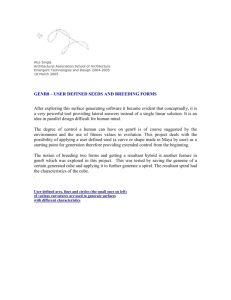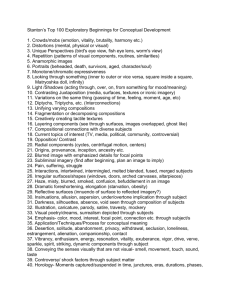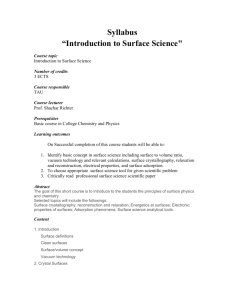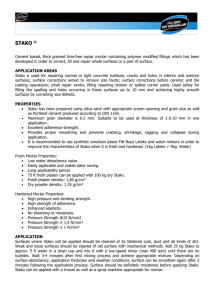Bridges Conference Proceedings Guidelines
advertisement
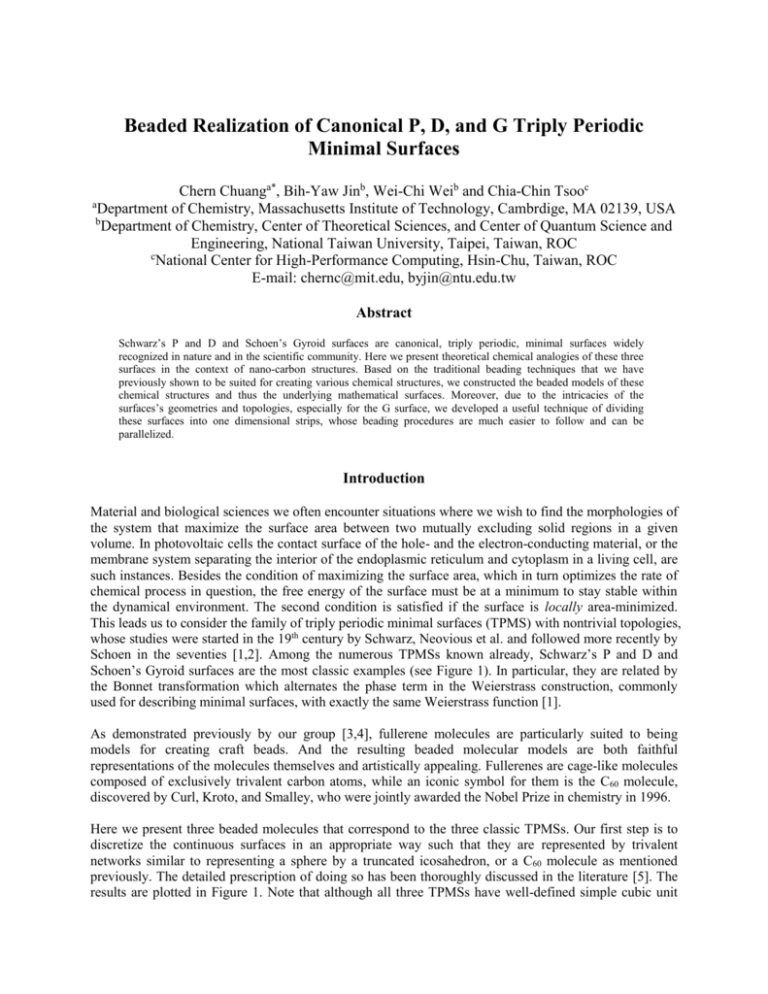
Beaded Realization of Canonical P, D, and G Triply Periodic Minimal Surfaces Chern Chuanga*, Bih-Yaw Jinb, Wei-Chi Weib and Chia-Chin Tsooc a Department of Chemistry, Massachusetts Institute of Technology, Cambrdige, MA 02139, USA b Department of Chemistry, Center of Theoretical Sciences, and Center of Quantum Science and Engineering, National Taiwan University, Taipei, Taiwan, ROC c National Center for High-Performance Computing, Hsin-Chu, Taiwan, ROC E-mail: chernc@mit.edu, byjin@ntu.edu.tw Abstract Schwarz’s P and D and Schoen’s Gyroid surfaces are canonical, triply periodic, minimal surfaces widely recognized in nature and in the scientific community. Here we present theoretical chemical analogies of these three surfaces in the context of nano-carbon structures. Based on the traditional beading techniques that we have previously shown to be suited for creating various chemical structures, we constructed the beaded models of these chemical structures and thus the underlying mathematical surfaces. Moreover, due to the intricacies of the surfaces’s geometries and topologies, especially for the G surface, we developed a useful technique of dividing these surfaces into one dimensional strips, whose beading procedures are much easier to follow and can be parallelized. Introduction Material and biological sciences we often encounter situations where we wish to find the morphologies of the system that maximize the surface area between two mutually excluding solid regions in a given volume. In photovoltaic cells the contact surface of the hole- and the electron-conducting material, or the membrane system separating the interior of the endoplasmic reticulum and cytoplasm in a living cell, are such instances. Besides the condition of maximizing the surface area, which in turn optimizes the rate of chemical process in question, the free energy of the surface must be at a minimum to stay stable within the dynamical environment. The second condition is satisfied if the surface is locally area-minimized. This leads us to consider the family of triply periodic minimal surfaces (TPMS) with nontrivial topologies, whose studies were started in the 19th century by Schwarz, Neovious et al. and followed more recently by Schoen in the seventies [1,2]. Among the numerous TPMSs known already, Schwarz’s P and D and Schoen’s Gyroid surfaces are the most classic examples (see Figure 1). In particular, they are related by the Bonnet transformation which alternates the phase term in the Weierstrass construction, commonly used for describing minimal surfaces, with exactly the same Weierstrass function [1]. As demonstrated previously by our group [3,4], fullerene molecules are particularly suited to being models for creating craft beads. And the resulting beaded molecular models are both faithful representations of the molecules themselves and artistically appealing. Fullerenes are cage-like molecules composed of exclusively trivalent carbon atoms, while an iconic symbol for them is the C60 molecule, discovered by Curl, Kroto, and Smalley, who were jointly awarded the Nobel Prize in chemistry in 1996. Here we present three beaded molecules that correspond to the three classic TPMSs. Our first step is to discretize the continuous surfaces in an appropriate way such that they are represented by trivalent networks similar to representing a sphere by a truncated icosahedron, or a C60 molecule as mentioned previously. The detailed prescription of doing so has been thoroughly discussed in the literature [5]. The results are plotted in Figure 1. Note that although all three TPMSs have well-defined simple cubic unit cells, for clarity we removed some of the disconnected parts of the D surface in the unit cell and rotated it for a sharper analogy with respect to the diamond lattice, which it was named after. In the second row, the fullerene counterparts of the surfaces are drawn. While the majority of the polygons are hexagonal and painted in white, the loci where the negative Gaussian curvature resides correspond to the location of eight-membered rings and are shaded. Figure 1: The three canonical TPMSs and their graphitic counterparts. (a) Schwarz’s P surface. (b) Schwarz’s D surface. (c) Schoen’s G surface. The next and the last step is to simply work out the actual beading procedure. For extended structures like the TPMSs, the number of beads needed is usually around two or three thousand. And it typically takes a skillful beader up to several weeks to complete the sculpture. Thus to make these models the best way is to divide and conquer: individual beaders first work out each of the unit cells comprising the whole model, then the model is completed by stitching the unit cells up. We found that while it is relatively easy to find our way dividing the P and D TPMSs into beadable unit cells, the exotic geometry and topology of the G TPMS makes it extremely difficult to keep track of where we are during the beading process. We have been attempting the beaded model of the G surface since long ago when we learned about this surface. But it was not until last year when we finally came up with a nice way of dividing it into clean pieces and we were able to finish the beading. Square Planar Lattice Decomposition of TPMSs So here we briefly describe how this magical division of the G TPMS is done. Before taking a close look at the structure of G TPMS, it is instructive to first examine its close relatives Schwarz’s P and D surfaces. If we cut the cubic unit cells through the axes of twofold rotational symmetries, we find that they are composed of subunits of the shapes resembling catenoids and helicoids, which are themselves (onedimensional) periodic minimal surfaces. See part (a) and (b) of Figure 2. It is well known that a catenoid can be isometrically and continuously deformed into a helicoid. During the deformation it still possesses the property of being minimal, that is, having zero mean curvature. (The reverse is not always true.) It is this curious observation that led us to suspect that the G surface might also be decomposed into one dimensional subunits related to a surface that can be classified as a certain middle point along that continuous transformation. This turns out to be true, though we are not claiming any mathematical rigor. However one of the purposes of this paper is to arouse the interest of mathematicians to rationalize this observation. As shown in the second row of Figure 2, if one follows the chains of shaded octagons for the P surface one would trace out a circle; for the D surface a twisted straight line; and for the G surface a helical curve with its pitch being eight times the radius. Figure 2: Square planar lattice decomposition of the three surfaces. (a) Schwarz’s P surface. (b) Schwarz’s D surface. (c) Schoen’s G surface. So now the route has been set up. First one can work out these cylindrical, twisted, or helical strips to some prescribed length. Then by identifying the common polygonal faces that adjacent strips share, one can sew the strips together to complete the entire beaded model. Beaded TPMSs Here we present the pictures of the finished beaded TPMS in Figure 3 and 4. In all three beadworks, eight-membered rings are represented by colored beads while hexagons are white. In particular, despite the help from the decomposition schemes mentioned above, it is still quite difficult to deal with the final sewing procedure for the G TPMS. Thus we deliberately differentiate octagons with different face normal directions by different colors of beads. In the right-handed Cartesian coordinates, eight-membered rings with face-normal to the x-axis are represented by purple beads, whereas ones along y-axis and z-axis are blue and green, respectively. Figure 3: Beaded Triply Periodic Minimal Surfaces. (a) Schwarz’s P surface. (b) Schwarz’s D surface. Figure 4: Beaded Gyroid Surface. We refer interested readers to our blog where some hundreds of other beaded molecular structures are listed and categorized [6]. Acknowledgements. We wish to thank the National Science Council, Taiwan, R.O.C. for its financial support of this project. References [1] D. A. Hoffman, Some Basic Facts, Old and New, about Triply Periodic Embedded Minimal Surfaces, J. Phys. Colloques Vol. 51, C7-197-208, 1990. [2] A. H. Schoen, Infinite Periodic Minimal Surfaces without Self-Intersection, NASA Technical Note, TN D-5541, 1970. [3] B.-Y. Jin, C. Chuang, C.-C. Tsoo, Constructing Molecules with Beads: The Geometry of Topologically Nontrivial Fullerenes, Proceedings of Bridges: Mathematics, Music, Art, Architecture, Culture pp. 391-394, 2010. [4] B.-Y. Jin, C. Chuang, C.-C. Tsoo, Desiging Sculptures Inspired by Symmetric High-Genus Fullerenes with Mathematical Beading, Proceedings of Bridges: Mathematics, Music, Art, Architecture, Culture pp. 523-526, 2011. [5] H. Terrones, Curved Graphite and its Mathematical Transformation, J. Math. Chem. Vol. 15, pp. 143156, 1994. [6] http://thebeadedmolecules.blogspot.com.



